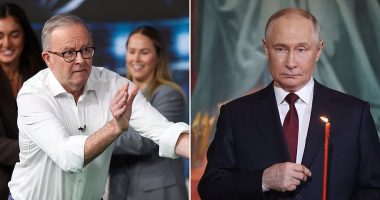Australia is the world’s top destination for ultra-wealthy individuals because it doesn’t have inheritance taxes and favours wealthy foreigners, a global investment migration consultancy says.
The United Arab Emirates lost its top spot to Australia this year.
This meant Australia was the most popular country for migrating millionaires for the first time since 2019, with 5,200 high-net worth individuals expected to migrate in 2023 during a skills shortage.
Tony Le Nevez, the managing partner of Henley & Partners in Australia, said the absence of inheritance taxes was a major factor, along with visa programs designed to attract the very wealthy.
‘What is it about Australia that has it consistently mentioned as the millionaires’ migration destination of choice?


Australia is the world’s top destination for ultra-wealthy individuals because it doesn’t have inheritance taxes and favours wealthy foreigners, a global investment migration consultancy Henley & Partners says (pictured are spectators at Sydney’s Royal Randwick Racecourse)
‘Is it the climate and lifestyle, the world-class education and healthcare, the distance from global crisis hotspots, or is it the fact that, unlike the UK and the USA, Australia has no inheritance taxes or death duties?
‘The answer is, all of the above, plus some very attractive visa programs aimed at attracting highly skilled professionals.’
Australia abolished inheritance taxes in July 1979, a year after Queensland’s eccentric National Party premier Joh Bjelke-Petersen led the charge to get rid of death duties.
The other states copied Queensland and saw Liberal prime minister Malcolm Fraser scrap the federal inheritance tax.
In the United States, the Internal Revenue Service levies an estate tax when the property of a dead person is transferred.
The UK has a 40 per cent inheritance tax for the value of estates worth more than £325,000.
Australia also has special visa programs to attract high-net worth individuals, which Henley & Partners defines as someone having $US1million or $A1.478million in assets.
But to be considered for one category of the 188 business visa, an ultra-wealthy individual seeking permanent residency in Australia needs to invest at least $2.5million.
To be eligible, they must provide the funds for a project nominated by a state or territory government since July 2021.


Australia was the most popular country for migrating millionaires for the first time since 2019, with 5,200 high-net worth individuals expected to migrate in 2023 during a skills shortage (pictured is a panoramic view of Sydney Harbour taken from Vaucluse in the eastern suburbs)
Henley & Partners expected 5,200 high net worth individuals to move to Australia in 2023, ahead of the UAE’s influx of 4,500 millionaires, Singapore’s elite intake of 3,200 and the United States with 2,100 new cashed-up arrivals.
Australia had the top spot from 2015 to 2019 before Covid stopped a lot of global migration.
The UAE was the top destination for the very rich in 2022.
Mr Le Nevez said Prime Minister Anthony Albanese’s Labor government was likely to continue favouring skilled migrants, which would include high-net worth individuals investing in businesses.
‘In May 2022, Australia had a change of government and almost immediately the incoming government announced an increase to the permanent migration program and a review of the immigration system,’ he said.
‘Like many developed countries, Australia faces a severe skills shortage and an aging population.
‘The review recommended major changes to the way Australia manages its visa programs, but importantly it restated the long-held view that the migration of highly skilled people can help increase Australians’ standard of living by contributing to higher productivity levels in the economy.’
A record 387,000 migrants moved to Australia in 2022 and Treasury is expecting that annual net figure to hit 400,000 by the end of June.


Home Affairs Minister Clare O’Neill in April said that while she wasn’t particularly keen on the 188 category visas for the ultra-wealthy, she wouldn’t be abolishing them
In a bid to stop exploitation, Home Affairs Minister Clare O’Neill in April announced the Temporary Skilled Migration Income Threshold would increase to $70,000, up from $53,900 from July 1.
Ms O’Neill said that while she would keep the 188 visas for wealthy migrants, she wasn’t particularly keen on them, as she announced policy changes following a migration system review.
‘The business investment visas is part of this broader class with the significant investor visa which was designed to bring capital and entrepreneurs to our country, and there are some quite – on the record significant issues with those,’ she told the National Press Club in April.
‘We haven’t said that we will abolish those programs.
‘What we have said is that they need a radical restructure as part of the work that we’re doing and I think this needs to be folded into the broader conversation about highly skilled people who we see as creating the future jobs for Australians and now how we manage them in.’
Unemployment in May fell to 3.6 per cent, down from 3.7 per cent in April, putting it closer to March’s 48-year low of 3.5 per cent.






